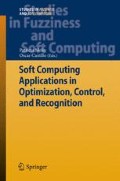Abstract
This paper proposes a new approach to simulating language evolution; it expands on the original work done by Lee and Zadeh on Fuzzy Grammars and introduces a Type-2 Fuzzy Grammar. Ants in an Ant Colony Optimization algorithm are given the ability of embedding a message on the pheromone using a Type-2 Fuzzy Grammar. These ants are able to gradually adopt a foreign language by adjusting the grades of membership of their grammar. Results that show the effect of uncertainty in a language are given.
Access this chapter
Tax calculation will be finalised at checkout
Purchases are for personal use only
Preview
Unable to display preview. Download preview PDF.
References
Alvarado-Magaña, J.P., Rodríguez-Díaz, A., Castro, J.R., Castillo, O.: Simulation of Language Evolution using Fuzzy Grammars. In: 31st Annual NAFIPS Meeting (2012)
De Boer, B.: Emergent Vowel Systems in a Population of Agents. In: Proceedings of ECAL 1997 (1997)
Briscoe, T.: Language Acquisition: The Bioprogram Hypothesis and the Baldwin Effect. MS, Computer Laboratory, University of Cambridge (1997)
Castro, J.R., Castillo, O., Melin, P., Rodríguez-Díaz, A.: A hybrid learning algorithm for a class of interval type-2 fuzzy neural networks. Inf. Sci. 179(13), 2175–2193 (2009)
Castillo, O., Melin, P., Pedrycz, W.: Design of interval type-2 fuzzy models through optimal granularity allocation. Appl. Soft Comput. 11(8), 5590–5601 (2011)
Chiswick, B.R., Miller, P.W.: A Model of Destination-Language Acquisition: Application to Male Immigrants in Canada. Demography 38(3) (2001)
Chomsky, N.: Government and Binding, Foris, Dordrech (1981)
Cocke, J., Schwartz, J.T.: Programming Languages and Their Compilers. Courant Institute of Mathematical Sciences, New York (1970)
Deacon, T.: The Symbolic Species. Penguin, London (1997)
Dorigo, M., Di Caro, G.: The Ant Colony Optimization Meta-Heuristic. In: New Ideas in Optimization. McGraw-Hill (1999)
Dustmann, C., Fabbri, F.: Language Proficiency and Labour Market Performance of Immigrants in the UK. The Economic Journal 113(489) (2003)
Fernald, A., Simon, T.: Expanded intonation contours in mother’s speech to newborns. Developmental Psychology 20, 104–113 (1984)
Hashimoto, T., Ikegami, T.: Emergence of net-grammar in communicating agents. BioSystems 38, 1–14 (1998)
Hutchins, E., Hazelhurst, B.: How to invent a lexicon. The development of shared symbols in interaction. In: Artificial Societies: The Computer Simulation of Social Life. UCL Press, London
Jim, K.-C., Lee Giles, C.: Talking Helps: Evolving Communicating Agents for the Predator-Prey Pursuit Problem. Artificial Life 6(3), 237–254 (2000)
Kasami, T.: An efficient recognition and syntax analysis algorithm for context-free languages. Technical Report AFCRL-65-758, Air Force Cambridge Research Laboratory, Bedford, Massachusetts (1965)
Kegl, J.: Conference Report: Linguistic Society of America Meeting. Signpost 7(1) (1994)
Kegl, J.: The Nicaraguan Sign Language Project: An Overview. Signpost 7(1) (1994)
Lee, E.T., Zadeh, L.A.: Note on fuzzy languages. Information Sciences 1, 421–434 (1969)
Mendel, J.M.: Uncertain Rule-Based Fuzzy Logic Systems: Introduction and New Directions. Prentice-Hall, Upper Saddle River (2001)
Perfors, A.: Simulated Evolution of Language. Journal of Artificial Societies and Social Simulation 5(2) (2000)
Pinker, S., Bloom, P.: Natural language and natural selection. Behavioural and Brain Sciences 13, 707–784 (1990)
Pinker, S.: The Language Instinct. William Morrow and Company (1994)
Pinker, S.: Why the child holded the baby rabbits: A case study in language acquisition. In: Language: An invitation to Cognitive Science, 2nd edn., vol. 1, pp. 107–133. MIT Press, Cambridge (1995)
Senghas, A.: The Development of Nicaraguan Sign Language via the Language Acquisition Process. In: BUCLD 19: Proceedings of the 19th Annual Boston University Conference on Language Development. Boston Cascadilla Press (1995)
Shipley, E., Kuhn, I.: A constraint on comparisons: equally detailed alternatives. Journal of Experimental Child Psychology 35, 195–222 (1983)
Tomasello, M.: First words: A case study of early grammatical development. Cambridge University Press, Cambridge (1992)
Veglery, A.: Differential Social Integration among First Generation Greeks in New York. International Migration Review 22(4) (1988)
Younger, D.H.: Recognition and parsing of context-free languages in time n3. Information and Control 10(2), 372–375 (1967)
Zadeh, L.A.: The Concept of a Linguistic Variable and Its Application to Approximate Reasoning. Information Sciences 8, 199–249 (1975)
Author information
Authors and Affiliations
Editor information
Editors and Affiliations
Rights and permissions
Copyright information
© 2013 Springer-Verlag Berlin Heidelberg
About this chapter
Cite this chapter
Alvarado-Magaña, J.P., Rodríguez-Díaz, A., Castro, J.R., Castillo, O. (2013). Type-2 Fuzzy Logic Grammars in Language Evolution. In: Melin, P., Castillo, O. (eds) Soft Computing Applications in Optimization, Control, and Recognition. Studies in Fuzziness and Soft Computing, vol 294. Springer, Berlin, Heidelberg. https://doi.org/10.1007/978-3-642-35323-9_11
Download citation
DOI: https://doi.org/10.1007/978-3-642-35323-9_11
Publisher Name: Springer, Berlin, Heidelberg
Print ISBN: 978-3-642-35322-2
Online ISBN: 978-3-642-35323-9
eBook Packages: EngineeringEngineering (R0)

